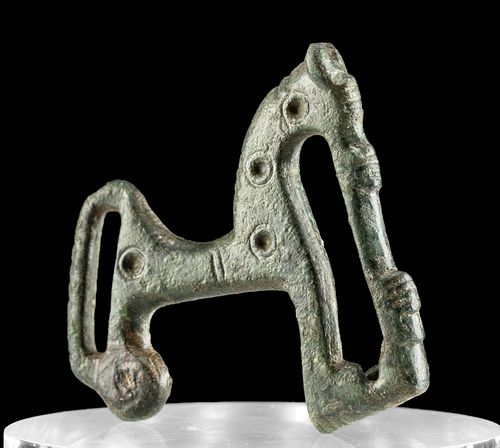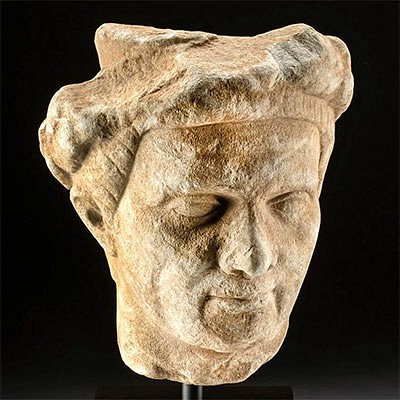Ancient Iberian / Celtic Bronze Horse Fibula
Lot 51
About Seller
Artemis Fine Arts
686 S Taylor Ave, Ste 106
Louisville, CO 80027
United States
Selling antiquities, ancient and ethnographic art online since 1993, Artemis Gallery specializes in Classical Antiquities (Egyptian, Greek, Roman, Near Eastern), Asian, Pre-Columbian, African / Tribal / Oceanographic art. Our extensive inventory includes pottery, stone, metal, wood, glass and textil...Read more
Estimate:
$1,000 - $1,500
Absentee vs Live bid
Two ways to bid:
- Leave a max absentee bid and the platform will bid on your behalf up to your maximum bid during the live auction.
- Bid live during the auction and your bids will be submitted real-time to the auctioneer.
Bid Increments
| Price | Bid Increment |
|---|---|
| $0 | $25 |
| $300 | $50 |
| $1,000 | $100 |
| $2,000 | $250 |
| $5,000 | $500 |
| $10,000 | $1,000 |
| $20,000 | $2,500 |
| $50,000 | $5,000 |
| $100,000 | $10,000 |
| $200,000 | $20,000 |
About Auction
By Artemis Fine Arts
Jun 1, 2023
Set Reminder
2023-06-01 10:00:00
2023-06-01 10:00:00
America/New_York
Bidsquare
Bidsquare : Ancient | Asian | Ethno | Native American Art
https://www.bidsquare.com/auctions/artemis-gallery/ancient-asian-ethno-native-american-art-12905
Featuring classical antiquities, ancient, and ethnographic art from cultures encompassing the globe. Egyptian, Greek, Roman, Near Eastern, Asian, Pre-Columbian, Native American, African / Tribal, Oceanic, Spanish Colonial, Fossils, more! All legally acquired, legal to sell. Satisfaction guaranteed. Artemis Fine Arts info@artemisgallery.com
Featuring classical antiquities, ancient, and ethnographic art from cultures encompassing the globe. Egyptian, Greek, Roman, Near Eastern, Asian, Pre-Columbian, Native American, African / Tribal, Oceanic, Spanish Colonial, Fossils, more! All legally acquired, legal to sell. Satisfaction guaranteed. Artemis Fine Arts info@artemisgallery.com
- Lot Description
Western Europe, Spain / Portugal, Iberian, Celtic culture, ca. 3rd to 2nd century BCE. A delightful leaded bronze fibula in the shape of a horse, known as "de caballito," boasting a schematic form of an arched neck, a lengthy tail, a slender snout, and a flattened body adorned with punched concentric circles. In the Iron age, fibulae and brooches were not only used to secure cloaks and other garments, but also to indicate the social status of the wearer. Horse fibulae, like this example, are considered representative of the male equestrian elite, yet also had a symbolic meaning associated with death; wearers of the fibulae believed the horse was a psychopomp animal that escorted the dead to the afterlife. The object hanging from the horse’s snout is thought to be the head of a vanquished foe or the soul of the deceased. Size: 1.6" W x 1.4" H (4.1 cm x 3.6 cm)
The term Celtic-Iberian refers to a group of peoples who lived in the pre-Roman era in northern and central Spain or in the region between the Iberian tribes of the Mediterranean coast on the Iberian peninsula and the Celtic tribes of the interior of the peninsula. Largely it refers incorrectly to the totality of all ancient Celtic and Iberian tribes on the Iberian Peninsula.
Provenance: private New York, USA collection, acquired prior to 1974
All items legal to buy/sell under U.S. Statute covering cultural patrimony Code 2600, CHAPTER 14, and are guaranteed to be as described or your money back.
A Certificate of Authenticity will accompany all winning bids.
We ship worldwide and handle all shipping in-house for your convenience.
#176100Missing spring and pin impeding wearability. Light surface wear as shown, but otherwise in overall excellent condition with nice green patina and ample remaining detail.Condition
- Shipping Info
-
All shipping is handled in-house for your convenience. Your invoice from Artemis Gallery will include shipping calculation instructions. If in doubt, please inquire BEFORE bidding for estimated shipping costs for individual items.
-
- Buyer's Premium



 EUR
EUR CAD
CAD AUD
AUD GBP
GBP MXN
MXN HKD
HKD CNY
CNY MYR
MYR SEK
SEK SGD
SGD CHF
CHF THB
THB













